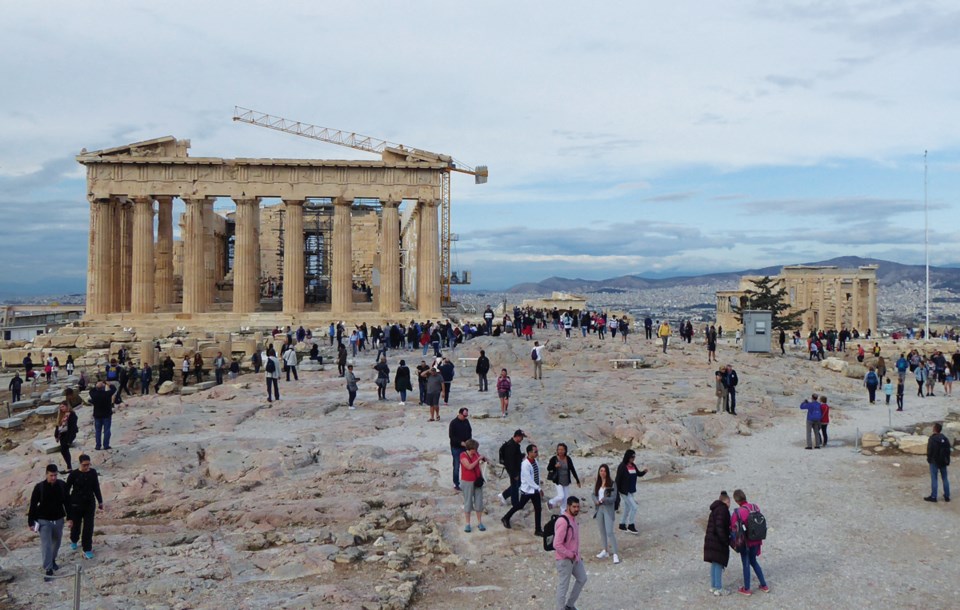Our Mediterranean cruise starts with two days in the heart of old Athens. Four blocks from our hotel, a pathway takes us along a hillside through newly excavated ruins toward the Acropolis. We imagine goddess Athena’s birthday procession winding its way from the agora. Costumed dancers, lively musicians, young girls hoisting drinking horns and aged men carrying olive branches paraded merrily up to the top following similar paths.
Below us lies Theatre of Dionysus, early home to riotous festivals. Later, tragedies by Sophocles, Euripides, Aeschylus – and Aristophanes’ bawdy comedies – played there to 17,000 patrons seated on 67 limestone tiers. Nearby, the smaller Odeon of Herodes Atticus still holds theatrical and musical performances.
Worn slippery-smooth by sandaled feet, the steps of the Sacred Way lead up into the Acropolis. Within the Propylaea’s towering gateway, one placard tells us about wondrous paintings once adorning its immense north wing picture gallery and gold stars studding the central hall’s blue ceilings.
With four symmetrical columns at front and back, small square Temple of Athena Nike perches above on the right. Fragmented friezes depict a gathering of Olympian gods and Athens’ victorious battles against other Greek states and the Persians. To the northeast, stands the wonderful marble Erechtheion. Six graceful maidens in long flowing garments support its southern porch. These caryatids gaze serenely toward the Parthenon. According to legend, Athena defeated Poseidon here to become the city’s supreme patron. This temple honoured these fierce competitors.
Also dedicated to Athena, the Parthenon still dominates this celebrated site. Exemplifying classical Greek grandeur, eight fluted columns support each end, 17 each side. Completed in the fifth century BC, this magnificent temple remains one of the world’s most iconic structures. Another plaque pictures Athena’s 12-metre gold and ivory statue standing inside. Helmeted with sphinxes and griffins, bejeweled eyes blazing and golden dress flying, her mighty figure became a wonder of the ancient world. She attracted pilgrims from near and afar.
A stone cliff-side platform provides breathtaking panoramas of the Temple of Olympian Zeus, Olympic stadium and old marketplace known nowadays as the Plaka. Shaded by olive trees along the Panathenaic Way, we return there to relish authentic Greek lunches in a family-run taverna.
At the outstanding new Acropolis Museum nearby, glass flooring reveals an unearthed neighbourhood just below the main entrance. Inside, a wide ramp mimics the climb to the Acropolis. Commonplace items used in ancient daily life fill its side shelves.
One gallery displays many ancient sculptures, including the calf-bearer from 570 BC and a poignant relief of a young Athena mourning. Another presents the Parthenon’s reproduced frieze showing gods and giants, centaurs, Athenians and Amazons and the Trojan War.
On the top floor, glass walls frame the magnificent Acropolis above. A film details its extraordinary history. Athenian statesman Pericles built the monumental Parthenon and other temples during the Golden Age of Greece. Eventually the splendid structure evolved into a Christian Church and much later, a munitions depot.
Foreign archeologists ransacked the Parthenon’s treasures. Two-thirds of the original artwork known as the Elgin Marbles resides in London’s British Museum.
Next morning, we walk to Hadrian’s Arch. Illustrated plaques explain that Emperor Hadrian built this gigantic entrance into Athens’ new Roman sector. The previous year, he constructed the adjacent Temple of Olympian Zeus, the largest temple in antiquity. Of 104 ultra tall Corinthian columns, 15 remain. He’d placed a giant gold and ivory Zeus inside and alongside, an equally large, resplendent statue of himself.
After browsing the Plaka’s little shops, we head to the port of Piraeus, board the elegant Viking Star and continue our explorations of civilizations transcending time.
See Viking itineraries at www.vikingcruises.com.



